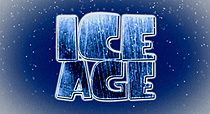
Cast * Story * Interesting Facts * Interviews * Behind the Scenes

Cast * Story * Interesting Facts * Interviews * Behind the Scenes
 Directed
by: Chris Wedge
Directed
by: Chris Wedge
Written by: Michael Berg
Music by: David Newman (Anastasia)
Production Start Date: July 5, 2000
Released on: March 15, 2002
Running Time: 81 minutes
Budget: $58 million (but industry estimates
agreed on a higher $75 million tag price) plus $35 million in marketing
costs
U.S. Opening Weekend: $46.312 million
over 3,316 screens
Box-Office: $176.39 million in the U.S.,
$378.4 million worldwide
Video Revenue: $264 million in DVD and
VHS rentals and sales
 |
 |
 |
 |
 |
 |
Manfred the woolly Mammoth... Ray Romano
Sid the Sloth... John Leguizamo ("Super
Mario Bros")
Jennifer the Sloth... Jane Krakowski ("Ally
MacBeal")
The Leader of the Saber-Toothed Tiger...
Goran Visnjic ("Practical Magic")
Sylvia the Sloth... Kristen Johnston ("Third Rock to the Sun"),
this character was cut from the movie
Diego the Sabertooth... Denis Leary ("A
Bug's Life")
Scrat... Chris Wedge
A human infant (the very first American, named Roshan), is found by
a group of dysfuncional Pliestocene mammals that includes a woolly mammoth,
a saber-toothed tiger, and a pair of giant sloths. Together, they try to
reunite the baby with his parents.
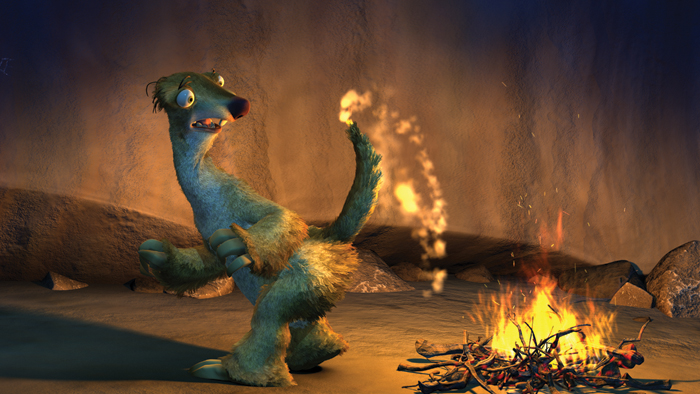 |
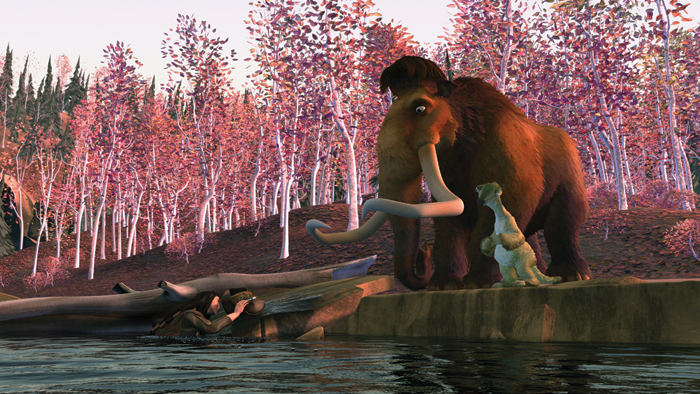 |
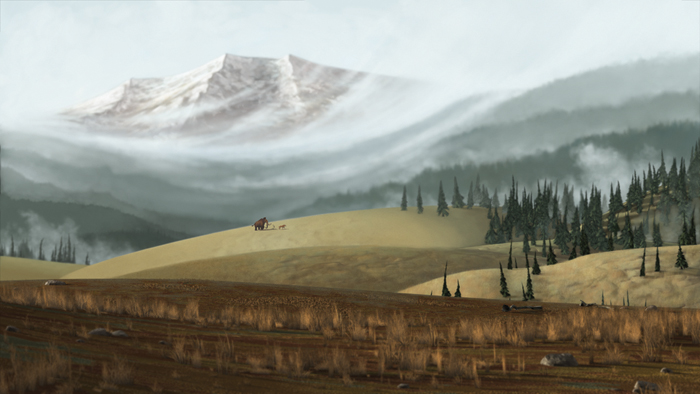 |
![]() Fox originally
conceived the film as a hand-drawn traditionally animated effort, but opted
to take the CG route by late-'98 after witnessing the successes of Antz
and A Bug's Life. The project was initially
one of several being considered for Fox's traditional animation studio
headed by Don Bluth--which has since closed.
Fox originally
conceived the film as a hand-drawn traditionally animated effort, but opted
to take the CG route by late-'98 after witnessing the successes of Antz
and A Bug's Life. The project was initially
one of several being considered for Fox's traditional animation studio
headed by Don Bluth--which has since closed.

![]() Don Bluth and
Gary Goldman confirmed that both read the original script back in 1997,
when they were with Fox. It was a candidate for the list of projects for
them to produce for Fox. "Bill Mechanic sent Ice Age over for us
to read for a traditionally animated movie. He had told us he wanted to
differentiate Fox animation's stories from Disney. When we read it, it
read like Disney's Three Men and a Baby. When we told him this he
pulled it back for more thought. We suggested that maybe it would be good
as a CGI film. It would help to separate it from the standard Disney fare.
And, it did. This was before they bought VIFX or Blue Sky Studios It was
decided that it would be done as a 3D project." The famous director added
that "the opening to the film, in the original script, was very powerful.
It explained why Manfred was walking in the opposite direction of the migrating
herds. It also set up the reason why Manfred wanted nothing to do with
the human baby. The written opening was not used in the film."
Don Bluth and
Gary Goldman confirmed that both read the original script back in 1997,
when they were with Fox. It was a candidate for the list of projects for
them to produce for Fox. "Bill Mechanic sent Ice Age over for us
to read for a traditionally animated movie. He had told us he wanted to
differentiate Fox animation's stories from Disney. When we read it, it
read like Disney's Three Men and a Baby. When we told him this he
pulled it back for more thought. We suggested that maybe it would be good
as a CGI film. It would help to separate it from the standard Disney fare.
And, it did. This was before they bought VIFX or Blue Sky Studios It was
decided that it would be done as a 3D project." The famous director added
that "the opening to the film, in the original script, was very powerful.
It explained why Manfred was walking in the opposite direction of the migrating
herds. It also set up the reason why Manfred wanted nothing to do with
the human baby. The written opening was not used in the film."
![]() While the earliest
versions of the Ice Age script had been conceived more as an action
adventure-drama with comic relief, Fox began to seek a more comedic treatment
of the story with a contemporary edge. Even before Wedge came onto the
project at the end of 1998, Michael Berg was brought in to further develop
the comedy. "When I came in I said, 'I can't write for kids,'" said Berg,
"and they said, 'Great! Just write a good story.'" Berg stayed with the
project on and off for three years, which covered most of the production
period. He said the experience was, in part, a lesson in patience. "You
have the storyboard artists draw [the scripted scenes] and you get a version
you like, and you put it on story reels with the pictures and the temporary
voice track, and then the directors and artists have a lot of ideas they
want to explore," he said. "We had 30 options of some scenes and, as a
writer, you try to pull them back toward story and characters. In live
action, the actor or director might say, 'Can we take [the scene] this
way?' But they usually don't say that 30 times."
While the earliest
versions of the Ice Age script had been conceived more as an action
adventure-drama with comic relief, Fox began to seek a more comedic treatment
of the story with a contemporary edge. Even before Wedge came onto the
project at the end of 1998, Michael Berg was brought in to further develop
the comedy. "When I came in I said, 'I can't write for kids,'" said Berg,
"and they said, 'Great! Just write a good story.'" Berg stayed with the
project on and off for three years, which covered most of the production
period. He said the experience was, in part, a lesson in patience. "You
have the storyboard artists draw [the scripted scenes] and you get a version
you like, and you put it on story reels with the pictures and the temporary
voice track, and then the directors and artists have a lot of ideas they
want to explore," he said. "We had 30 options of some scenes and, as a
writer, you try to pull them back toward story and characters. In live
action, the actor or director might say, 'Can we take [the scene] this
way?' But they usually don't say that 30 times."
![]() In June 2000,
Fox doubled the work staff at its New York-based digital animation studio,
Blue Sky Animation, in order to start production on this project. This
came directly on the heels of the complete closing of the Fox Animation
facility in Phoenix after the commercial failure of Titan
A.E.
In June 2000,
Fox doubled the work staff at its New York-based digital animation studio,
Blue Sky Animation, in order to start production on this project. This
came directly on the heels of the complete closing of the Fox Animation
facility in Phoenix after the commercial failure of Titan
A.E.
![]() Back in
2000 when Ice Age was officially announced, DreamWorks Pictures
had reportedly a movie in the works by the same title, which was a post-apocalyptic
action epic -"think Waterworld with ice," according to insiders.
Back in
2000 when Ice Age was officially announced, DreamWorks Pictures
had reportedly a movie in the works by the same title, which was a post-apocalyptic
action epic -"think Waterworld with ice," according to insiders.
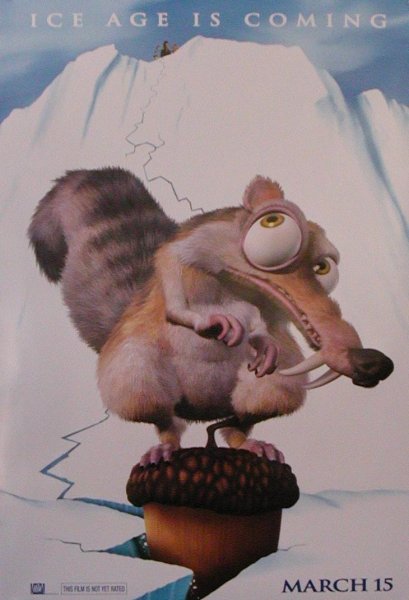
![]() Former senior
vice-president at 20th Century Fox Animation, Kevin Bannerman, talked in
April 2001 about how their efforts to make this project geared more towards
adults were stymied by the studio, and some scenes had to be toned down:
"We have definitely run into problems with violence in Ice Age and
had to rethink a lot of the humor. The studio wants a G rating on the movie,
and as a result we had to take some scenes out."
Former senior
vice-president at 20th Century Fox Animation, Kevin Bannerman, talked in
April 2001 about how their efforts to make this project geared more towards
adults were stymied by the studio, and some scenes had to be toned down:
"We have definitely run into problems with violence in Ice Age and
had to rethink a lot of the humor. The studio wants a G rating on the movie,
and as a result we had to take some scenes out."
![]() According to Jim
Hill, in early 2001, "executives at Fox were becoming extremely nervous
about this still-in-production CG flick. Given that the studio's last foray
into feature animation--their much hyped Summer 2000 release, Titan
A.E.--had ended disastrously, Fox studio execs reportedly quietly
approached Walt Disney Company officials to see if the Mouse might be interested
in taking Ice Age off of Fox's hands. Intrigued by their rival's offer,
senior officials at Disney Feature Animation supposedly screened Ice Age
at the Burbank lot early last spring. Days later, they discreetly returned
the work-in-progress print to the folks at Fox. Disney's verdict? Ice
Age was dreadful. According to the feedback that top level WDFA execs
allegedly gave Fox officials: The picture's character design was butt ugly.
The movie's storyline was predictable and derivative. So what does this
prove? That the execs at Walt Disney Feature Animation wouldn't know a
good movie even if it were just HANDED to them? Well, that's a little harsh.
But not too far from the truth."
According to Jim
Hill, in early 2001, "executives at Fox were becoming extremely nervous
about this still-in-production CG flick. Given that the studio's last foray
into feature animation--their much hyped Summer 2000 release, Titan
A.E.--had ended disastrously, Fox studio execs reportedly quietly
approached Walt Disney Company officials to see if the Mouse might be interested
in taking Ice Age off of Fox's hands. Intrigued by their rival's offer,
senior officials at Disney Feature Animation supposedly screened Ice Age
at the Burbank lot early last spring. Days later, they discreetly returned
the work-in-progress print to the folks at Fox. Disney's verdict? Ice
Age was dreadful. According to the feedback that top level WDFA execs
allegedly gave Fox officials: The picture's character design was butt ugly.
The movie's storyline was predictable and derivative. So what does this
prove? That the execs at Walt Disney Feature Animation wouldn't know a
good movie even if it were just HANDED to them? Well, that's a little harsh.
But not too far from the truth."
![]() Discussion between
DreamWorks and Fox to share distribution in Fox's animated Ice Age
movie have broken down in August 2001, resulting in Fox being the sole
distributor for the animated movie. Ice Age is a digitally-animated
feature film from Blue Sky Studios, a computer graphics imagery/feature
film animation studio and a division of Twentieth Century Fox Animation
Studios.
Discussion between
DreamWorks and Fox to share distribution in Fox's animated Ice Age
movie have broken down in August 2001, resulting in Fox being the sole
distributor for the animated movie. Ice Age is a digitally-animated
feature film from Blue Sky Studios, a computer graphics imagery/feature
film animation studio and a division of Twentieth Century Fox Animation
Studios.
![]() Ice Age
director Chris Wedge also said partnering up with Fox to make a feature
"felt like making a deal with the devil" -ouch, so much for promotion!
Ice Age
director Chris Wedge also said partnering up with Fox to make a feature
"felt like making a deal with the devil" -ouch, so much for promotion!
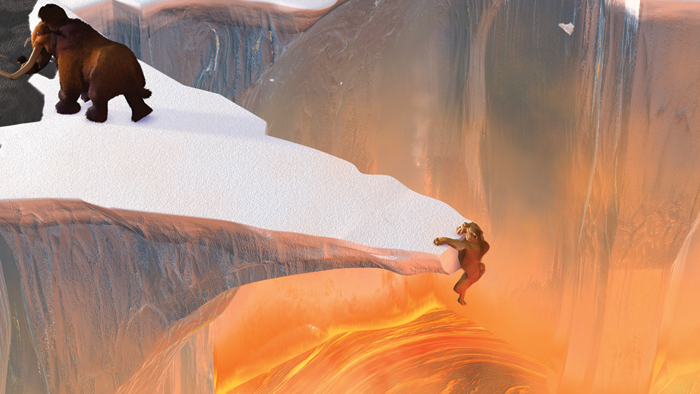
![]() Co-director Carlos
Saldanha capitalized on the persona Ray Romano built on TV's Everybody
Loves Raymond: "Ray is a big, lovable guy, just like his character,
who is a mammoth. When people hear his voice, they hear his warmth, this
feeling of being an honest, family guy." Saldanha found that choosing the
right actors helps establish tone. "[John] 'Leguizamo, in particular, can
give you anything you want. He gave us a tape of 20 different types of
voices that he thought might work for the character, and we just picked
one. The great thing with these guys is they're used to ad-libbing, so
they can add so much to make it even funnier."
Co-director Carlos
Saldanha capitalized on the persona Ray Romano built on TV's Everybody
Loves Raymond: "Ray is a big, lovable guy, just like his character,
who is a mammoth. When people hear his voice, they hear his warmth, this
feeling of being an honest, family guy." Saldanha found that choosing the
right actors helps establish tone. "[John] 'Leguizamo, in particular, can
give you anything you want. He gave us a tape of 20 different types of
voices that he thought might work for the character, and we just picked
one. The great thing with these guys is they're used to ad-libbing, so
they can add so much to make it even funnier."
![]() Production, which
was held up at Blue Sky Studios, headquartered in White Plains, NY, had
to be halted the week of September 11, 2001 after terrorist attacks at
the World Trade Center.
Production, which
was held up at Blue Sky Studios, headquartered in White Plains, NY, had
to be halted the week of September 11, 2001 after terrorist attacks at
the World Trade Center.
![]() James Earl Jones
was initially considered to supply the voice of wooly mammoth Manny, but
ultimately, director Chris Wedge just couldn't warm up to the idea. "We
needed more comedy. It took a while to get to it, but it was really perfect
once we thought of [Ray Romano]. Ray's voice is kind of deep and his delivery
is kind of slow, but he's also got a sarcastic wit behind it."
James Earl Jones
was initially considered to supply the voice of wooly mammoth Manny, but
ultimately, director Chris Wedge just couldn't warm up to the idea. "We
needed more comedy. It took a while to get to it, but it was really perfect
once we thought of [Ray Romano]. Ray's voice is kind of deep and his delivery
is kind of slow, but he's also got a sarcastic wit behind it."
![]() Philip Seymour
Hoffman (The Talented Mr. Ripley) was also approached to voice Diego.
Philip Seymour
Hoffman (The Talented Mr. Ripley) was also approached to voice Diego.
![]() Director Chris
Wedge provided his voice to the adorable Scrat!
Director Chris
Wedge provided his voice to the adorable Scrat!
![]() A subplot which
found Sid the sloth cozying up to a couple of females got whittled down
to just one scene. "It was too double entendre-y," says John Leguizamo.
"It was hilarious, but kids weren't laughing, and parents weren't either."
A subplot which
found Sid the sloth cozying up to a couple of females got whittled down
to just one scene. "It was too double entendre-y," says John Leguizamo.
"It was hilarious, but kids weren't laughing, and parents weren't either."
![]() Consequently,
early promo material and tie-in storybooks feature a female sloth named
Sylvia (voiced by Third Rock from the Sun's Kristen Johnston), but
the character was cut from the film after testing poorly with audiences
who found the character "abrasive." Sylvia's scenes will be included in
the DVD release.
Consequently,
early promo material and tie-in storybooks feature a female sloth named
Sylvia (voiced by Third Rock from the Sun's Kristen Johnston), but
the character was cut from the film after testing poorly with audiences
who found the character "abrasive." Sylvia's scenes will be included in
the DVD release.
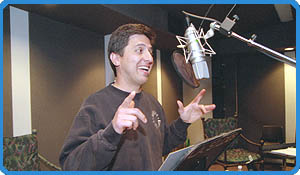
![]() Ray Romano (Manfred the Mammoth) explained that he was attracted
to this project because "it was my way to wean the audience to myself on
the big screen. My kids played a big part in it [too], as it was something
nice to share with them. [Now they] are obsessed like you can’t believe;
it’s almost scary. What have I created? I come home with this
stuff, like the Burger King toys. I want to speak to a shrink about
it to make sure we’re doin’ the right thing." His kids might think dad’s
cool and all, but they’re also critical. "They don’t like that Scrat steals
the show [an acorn-loving sabre-toothed squirrel]. That was their
comment as soon as they saw it: ‘Scrat, is in it too much.
I don’t like that, dad. It should be you’. " The actor adds that
he was challenged by the isolation and process of voicing an animated character.
"It was just physically difficult. You’re in front of the microphone
and you can’t move around or emote. For instance, there’s a scene
where I grab Diego and throw him against the wall and you’re in his face.
Every time we would do it, I’d have to (physically) do that and I couldn’t
move too far from the mic so you get that taken away." Then there’s
no actor. "I was never with another actor so there’s no give and
take there and no feedback."
Ray Romano (Manfred the Mammoth) explained that he was attracted
to this project because "it was my way to wean the audience to myself on
the big screen. My kids played a big part in it [too], as it was something
nice to share with them. [Now they] are obsessed like you can’t believe;
it’s almost scary. What have I created? I come home with this
stuff, like the Burger King toys. I want to speak to a shrink about
it to make sure we’re doin’ the right thing." His kids might think dad’s
cool and all, but they’re also critical. "They don’t like that Scrat steals
the show [an acorn-loving sabre-toothed squirrel]. That was their
comment as soon as they saw it: ‘Scrat, is in it too much.
I don’t like that, dad. It should be you’. " The actor adds that
he was challenged by the isolation and process of voicing an animated character.
"It was just physically difficult. You’re in front of the microphone
and you can’t move around or emote. For instance, there’s a scene
where I grab Diego and throw him against the wall and you’re in his face.
Every time we would do it, I’d have to (physically) do that and I couldn’t
move too far from the mic so you get that taken away." Then there’s
no actor. "I was never with another actor so there’s no give and
take there and no feedback."
![]() The Scrat "steals
the show," Ray Romano said. "They kept adding him in and adding him in.
I didn't know how big a part he had because he wasn't even in the script."
He adds, with mock menace, "But if I had known, I would have done something
about it." As director Chris Wedge, referring to the explainer for the
film's PG rating, says, "He's our hapless 'mild peril' poster child. He
never gives up. What makes it funny is he doesn't deserve any of it. He's
just trying to get by. Maybe he's autobiographical." Wedge gives credit
to character designer Peter de Save, a New Yorker magazine cover artist,
for originally inventing the Scrat. "Peter lives in Brooklyn and took research
trips to the Museum of Natural History. Pretty early on, he came up with
this little crazy guy, sort of a squirrel based on some lemur." The Scrat
doesn't speak, but he emits a series of sniffs, scratches and screeches
when need be. The voice talent involved? In the tradition of Walt Disney
squeaking for Mickey Mouse for several years, Wedge did the honors himself.
"When we were cutting story reels together and shooting storyboard drawings
under a video camera, I just got behind the mike and did all the noises,
trying to sound as manic as possible." A little too manic, perhaps. "By
the end, I couldn't do the Scrat anymore. I didn't have the energy. We
had to use the same screams over and over." Although he saved on having
to pay an extra salary for a voice actor, Wedge did have an unexpected
expense: "I had to buy a Screen Actors Guild card!"
The Scrat "steals
the show," Ray Romano said. "They kept adding him in and adding him in.
I didn't know how big a part he had because he wasn't even in the script."
He adds, with mock menace, "But if I had known, I would have done something
about it." As director Chris Wedge, referring to the explainer for the
film's PG rating, says, "He's our hapless 'mild peril' poster child. He
never gives up. What makes it funny is he doesn't deserve any of it. He's
just trying to get by. Maybe he's autobiographical." Wedge gives credit
to character designer Peter de Save, a New Yorker magazine cover artist,
for originally inventing the Scrat. "Peter lives in Brooklyn and took research
trips to the Museum of Natural History. Pretty early on, he came up with
this little crazy guy, sort of a squirrel based on some lemur." The Scrat
doesn't speak, but he emits a series of sniffs, scratches and screeches
when need be. The voice talent involved? In the tradition of Walt Disney
squeaking for Mickey Mouse for several years, Wedge did the honors himself.
"When we were cutting story reels together and shooting storyboard drawings
under a video camera, I just got behind the mike and did all the noises,
trying to sound as manic as possible." A little too manic, perhaps. "By
the end, I couldn't do the Scrat anymore. I didn't have the energy. We
had to use the same screams over and over." Although he saved on having
to pay an extra salary for a voice actor, Wedge did have an unexpected
expense: "I had to buy a Screen Actors Guild card!"

![]() "I couldn't figure
out how Sid was supposed to sound. I gave the director like, 30 different
voices," explained John Leguizamo. "I was in Australia doing Moulin
Rouge, and I just couldn't find Sid. But they'd sent me some tapes
from The Discovery Channel--giant sloths, all about how they store food
in their cheek pouches. I think, 'Stored food in their Cheek-pouches. SHTORED
food in dair sheek pouTCHEs.' Called them up and said, 'How's this? Zis
is SID. I found my VOISE! My mouf ish full!' Ice Age is the first
movie I can show to my kids. Nice and clean, this time!" Well, sort of.
"Kristen Johnston and I were recording our scenes together. Sort of a flirting
thing. And the material was a little, um, adult. And we got kinda outta
hand with the improvisations. They wound up cutting her out of the movie
altogether. Some of the cleaner stuff we did is on the DVD."
"I couldn't figure
out how Sid was supposed to sound. I gave the director like, 30 different
voices," explained John Leguizamo. "I was in Australia doing Moulin
Rouge, and I just couldn't find Sid. But they'd sent me some tapes
from The Discovery Channel--giant sloths, all about how they store food
in their cheek pouches. I think, 'Stored food in their Cheek-pouches. SHTORED
food in dair sheek pouTCHEs.' Called them up and said, 'How's this? Zis
is SID. I found my VOISE! My mouf ish full!' Ice Age is the first
movie I can show to my kids. Nice and clean, this time!" Well, sort of.
"Kristen Johnston and I were recording our scenes together. Sort of a flirting
thing. And the material was a little, um, adult. And we got kinda outta
hand with the improvisations. They wound up cutting her out of the movie
altogether. Some of the cleaner stuff we did is on the DVD."
![]() "Ice Age
was a very lean project," co-director Carlos Saldanha said "We got it in
on time and on budget - which is a very rare thing these days - and it
cost probably half the budget for Shrek."
Instead of spending time and money generating photo-realistic scenery and
characters, Saldanha and the team at Blue Sky Studios (led by Oscar-winning
animator Chris Wedge) created a prehistoric world that would still be familiar
to Elmer Fudd. The fur-rendering might be a touch down on Monsters
Inc. and the backgrounds might owe more to the geography of Wile
E. Coyote's backyard but Blue Sky are out to prove you don't need photo-realistic
CGI to make a successful movie. "There's this feeling in the industry that
we have to come up with the new standard every time we make a movie," says
Saldanha. "But because this is Fox's first animation, we were kinda out
of that loop. It takes more than just pure animation. What you need is
a balance of all the elements. If the visuals top the story you'll find
yourself just watching it for the visuals and Hollywood already produces
so many movies like that... they spend a $100 million and it makes back
like, ten percent 'cos there's no plot." Is the Blue Sky model likely to
be the way of the future? Saldanha thinks it might. "It's a very young
industry and it's a very dynamic industry. You can buy a PC now, take it
home and use the exact same software we used for Ice
Age. We get 16 and 17 year olds sending in reels they've
made at home that are just incredible."
"Ice Age
was a very lean project," co-director Carlos Saldanha said "We got it in
on time and on budget - which is a very rare thing these days - and it
cost probably half the budget for Shrek."
Instead of spending time and money generating photo-realistic scenery and
characters, Saldanha and the team at Blue Sky Studios (led by Oscar-winning
animator Chris Wedge) created a prehistoric world that would still be familiar
to Elmer Fudd. The fur-rendering might be a touch down on Monsters
Inc. and the backgrounds might owe more to the geography of Wile
E. Coyote's backyard but Blue Sky are out to prove you don't need photo-realistic
CGI to make a successful movie. "There's this feeling in the industry that
we have to come up with the new standard every time we make a movie," says
Saldanha. "But because this is Fox's first animation, we were kinda out
of that loop. It takes more than just pure animation. What you need is
a balance of all the elements. If the visuals top the story you'll find
yourself just watching it for the visuals and Hollywood already produces
so many movies like that... they spend a $100 million and it makes back
like, ten percent 'cos there's no plot." Is the Blue Sky model likely to
be the way of the future? Saldanha thinks it might. "It's a very young
industry and it's a very dynamic industry. You can buy a PC now, take it
home and use the exact same software we used for Ice
Age. We get 16 and 17 year olds sending in reels they've
made at home that are just incredible."
![]() John C. Donkin,
Blue Sky's associate producer, about the making of the studio and their
first feature. "When Ice Age was first read at Blue Sky, we were
thinking, 'This is the worst possible film we could try to produce as our
first feature: it's a travel film, all of the characters are furry, four-legged
animals...Oh! Except for the humans...Humans! And it takes place in the
great outdoors.' Computer generated films to date (at that time) did not
include furry four-legged talking animals standing next to raging waterfalls.
How could we possibly do this movie? (...) The actual length of production
(the point at which we started doing animation which ended up in the film)
ran about 65 weeks. The film is about 80 minutes in length -- that's a
little bit over a minute per week of actual production. On small projects
it's possible for different departments to work nearly simultaneously.
This is not possible on a large-scale project and requires a different
discipline both technically and creatively. When Blue Sky began production
on Ice Age, the studio consisted of approximately
65 people. At the height of production we grew to more than 170. Because
this was Blue Sky's first feature, we had to build up or create new departments.
These included Story, Layout, Art and Editorial. Chris Wedge is a demanding
director in that he is always pressing to have the best work on the screen,
and no detail is too small to scrutinize. The culture at Blue Sky Studios
is very much one of attention to detail. This attention comes out of the
fact that everyone who worked on Ice Age carried with them a passion:
a passion to do the absolute best job possible, as well as a passion for
the film to succeed. The importance of success in the collective at Blue
Sky led to extremely strong team building within and beyond individual
departments."
John C. Donkin,
Blue Sky's associate producer, about the making of the studio and their
first feature. "When Ice Age was first read at Blue Sky, we were
thinking, 'This is the worst possible film we could try to produce as our
first feature: it's a travel film, all of the characters are furry, four-legged
animals...Oh! Except for the humans...Humans! And it takes place in the
great outdoors.' Computer generated films to date (at that time) did not
include furry four-legged talking animals standing next to raging waterfalls.
How could we possibly do this movie? (...) The actual length of production
(the point at which we started doing animation which ended up in the film)
ran about 65 weeks. The film is about 80 minutes in length -- that's a
little bit over a minute per week of actual production. On small projects
it's possible for different departments to work nearly simultaneously.
This is not possible on a large-scale project and requires a different
discipline both technically and creatively. When Blue Sky began production
on Ice Age, the studio consisted of approximately
65 people. At the height of production we grew to more than 170. Because
this was Blue Sky's first feature, we had to build up or create new departments.
These included Story, Layout, Art and Editorial. Chris Wedge is a demanding
director in that he is always pressing to have the best work on the screen,
and no detail is too small to scrutinize. The culture at Blue Sky Studios
is very much one of attention to detail. This attention comes out of the
fact that everyone who worked on Ice Age carried with them a passion:
a passion to do the absolute best job possible, as well as a passion for
the film to succeed. The importance of success in the collective at Blue
Sky led to extremely strong team building within and beyond individual
departments."
![]() Beauty
and the Beast and Cats Don't Dance
art director Brian McEntee worked on the film.
Beauty
and the Beast and Cats Don't Dance
art director Brian McEntee worked on the film.
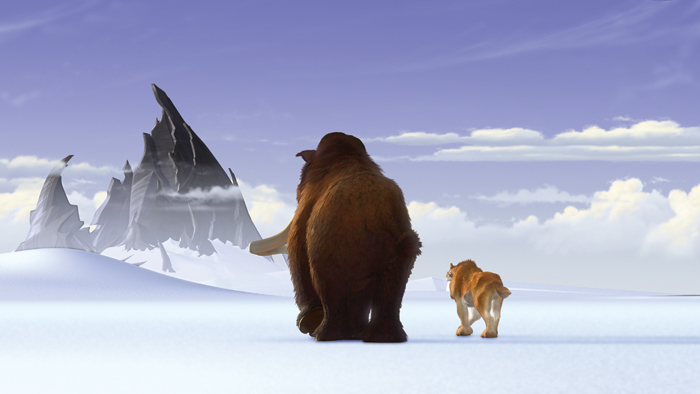
![]() "I know this
sounds strange," director Chris Wedge said, "but we didn't necessarily
know how to make a movie." Blue Sky ultimately adopted the assembly-line
method created by the Disney studio in the mid-1930's for Snow
White and the Seven Dwarfs, in which each worker specializes in
a single production area. "An assembly line sets a horrible burden on the
process," production manager Chuck Richardson admitted. "It demands inventory.
It consumes work. It demands people be creative on a schedule. It is very
wearying, because people don't realize how much work it is. Producing an
80-minute film is more work than they've ever done in their entire life
in a concentrated period." Early in the process, he continued, "people
freaked out, because I said, 'You're going to have to animate four seconds
a week.' They said: 'It's impossible. We've never animated that much!'
But every week their rates went up and, by the end, these nearly 30 animators
knew the characters so well they were masters at running them around."
The film was budgeted at two-thirds the cost of comparable computer features,
Mr. Richardson said. "We are using fewer people, the overhead is lower,
the lighting modelers and animators became very proficient, very fast."
"I know this
sounds strange," director Chris Wedge said, "but we didn't necessarily
know how to make a movie." Blue Sky ultimately adopted the assembly-line
method created by the Disney studio in the mid-1930's for Snow
White and the Seven Dwarfs, in which each worker specializes in
a single production area. "An assembly line sets a horrible burden on the
process," production manager Chuck Richardson admitted. "It demands inventory.
It consumes work. It demands people be creative on a schedule. It is very
wearying, because people don't realize how much work it is. Producing an
80-minute film is more work than they've ever done in their entire life
in a concentrated period." Early in the process, he continued, "people
freaked out, because I said, 'You're going to have to animate four seconds
a week.' They said: 'It's impossible. We've never animated that much!'
But every week their rates went up and, by the end, these nearly 30 animators
knew the characters so well they were masters at running them around."
The film was budgeted at two-thirds the cost of comparable computer features,
Mr. Richardson said. "We are using fewer people, the overhead is lower,
the lighting modelers and animators became very proficient, very fast."
![]() Director Chris
Wedge is regarded by many in the industry as the new John
Lasseter. Says Christopher Meledandri, Ice Age's executive producer
and head of Fox animation, "There's a childlike part of [director] Chris
Wedge that manifests itself in seeing the world in a wonderfully simplistic
way, so that an innocence comes through. For the time being, he declares,
"We are in the Chris Wedge business." Adds Fox co-chairman Tom Rothman,
"He is the real deal." Jeffrey Katzenberg, co-founder of DreamWorks, admitted
himself: "Chris Wedge is a brilliant artist and storyteller and showed
extraordinary promise."
Director Chris
Wedge is regarded by many in the industry as the new John
Lasseter. Says Christopher Meledandri, Ice Age's executive producer
and head of Fox animation, "There's a childlike part of [director] Chris
Wedge that manifests itself in seeing the world in a wonderfully simplistic
way, so that an innocence comes through. For the time being, he declares,
"We are in the Chris Wedge business." Adds Fox co-chairman Tom Rothman,
"He is the real deal." Jeffrey Katzenberg, co-founder of DreamWorks, admitted
himself: "Chris Wedge is a brilliant artist and storyteller and showed
extraordinary promise."
![]() The next project
at Blue Sky may involve robotic characters based on designs by children's
book author William Joyce (Rolie Polie Olie), but Fox is waiting
to see how Ice Age performs at the box
office before they green light any future projects. William Joyce is working
on this second feature since November 2001 -its coded title, which is intentionally
misleading, is FireMan.
The next project
at Blue Sky may involve robotic characters based on designs by children's
book author William Joyce (Rolie Polie Olie), but Fox is waiting
to see how Ice Age performs at the box
office before they green light any future projects. William Joyce is working
on this second feature since November 2001 -its coded title, which is intentionally
misleading, is FireMan.
![]() Ice Age's
$47.9 million opening weekend smashed the old three-day record for a March
release -$31.4 million for Jim Carrey's Liar Liar in 1997. It became
the third best animated opening of all time after Monsters,
Inc. ($62.6 million) and Toy Story
2 ($57.4 million) -and delivered the biggest opening ever for a
non-Disney animated film. Going into the weekend, Fox had forecast an opening
in the $30 million range -instead, it stood as the studio's fifth largest
opening ever!
Ice Age's
$47.9 million opening weekend smashed the old three-day record for a March
release -$31.4 million for Jim Carrey's Liar Liar in 1997. It became
the third best animated opening of all time after Monsters,
Inc. ($62.6 million) and Toy Story
2 ($57.4 million) -and delivered the biggest opening ever for a
non-Disney animated film. Going into the weekend, Fox had forecast an opening
in the $30 million range -instead, it stood as the studio's fifth largest
opening ever!
![]() The hit cartoon
was the first major studio film to debut simultaneously in a Spanish-dubbed
VHS version and on the new D-VHS high-definition format. The Spanish-language
tracks on the DVD and VHS will include celebrity voice talents from the
dubbed theatrical version of the film released in Latin America. Ice Age
was chosen for a simultaneous release on JVC's high definition D-Theater
VHS because it demonstrates the potential of the HD format, said
Peter Staddon, Fox's senior VP of marketing. "It's a CGI-animated digital
film created in the digital domain. In high-definition digital format,
it looks absolutely amazing. The difference between D-VHS and DVD is the
same as the difference between DVD and VHS."
The hit cartoon
was the first major studio film to debut simultaneously in a Spanish-dubbed
VHS version and on the new D-VHS high-definition format. The Spanish-language
tracks on the DVD and VHS will include celebrity voice talents from the
dubbed theatrical version of the film released in Latin America. Ice Age
was chosen for a simultaneous release on JVC's high definition D-Theater
VHS because it demonstrates the potential of the HD format, said
Peter Staddon, Fox's senior VP of marketing. "It's a CGI-animated digital
film created in the digital domain. In high-definition digital format,
it looks absolutely amazing. The difference between D-VHS and DVD is the
same as the difference between DVD and VHS."
![]() Sequel discussions
were taking place even before Ice Age made a cool haul at the box
office. "Serious discussions," according to director Chris Wedge. As for
plot secrets, Wedge says, "I think of the mammoth and the sloth in our
movie like Ralph Kramden and Ed Norton. The buddy comedy possibility are
endless."
Sequel discussions
were taking place even before Ice Age made a cool haul at the box
office. "Serious discussions," according to director Chris Wedge. As for
plot secrets, Wedge says, "I think of the mammoth and the sloth in our
movie like Ralph Kramden and Ed Norton. The buddy comedy possibility are
endless."
![]() John Leguizamo
confirmed in November 2002 that Ice Age 2 was "coming up. Yup, were
in talks right now. I mean it was a huge hit, it was an unexpected hit
for FOX that it revived their animation Dept [Laughs]. Yeah they had nailed
their window shut, locked it and now they had to get a crowbar and open
it up again."
John Leguizamo
confirmed in November 2002 that Ice Age 2 was "coming up. Yup, were
in talks right now. I mean it was a huge hit, it was an unexpected hit
for FOX that it revived their animation Dept [Laughs]. Yeah they had nailed
their window shut, locked it and now they had to get a crowbar and open
it up again."
![]() Director Chris
Wedge further commented that same month that he was indeed contemplating
the inevitable follow-up to Ice Age. "We're working on treatments
for it right now. I think the studio is certainly interested. I'm happy.
You get to know all these characters, and we have a million spinoff stories.
But I'm just kind of consumed by [Robots],
and I have to take it one step at a time." In February 2003, he confirmed
that he would executive produce the sequel that writing duo Peter Gaulke
and Gerry Swallow are penning.
Director Chris
Wedge further commented that same month that he was indeed contemplating
the inevitable follow-up to Ice Age. "We're working on treatments
for it right now. I think the studio is certainly interested. I'm happy.
You get to know all these characters, and we have a million spinoff stories.
But I'm just kind of consumed by [Robots],
and I have to take it one step at a time." In February 2003, he confirmed
that he would executive produce the sequel that writing duo Peter Gaulke
and Gerry Swallow are penning.
![]() The home-video
release of Ice Age generated over $115 million in revenue in less
than a week--compared to the $36 million generated by top-line animated
films (including Disney's Treasure Planet
and Adam Sandler's 8 Crazy Nights) in theatrical release over the
same Thanksgiving weekend.
The home-video
release of Ice Age generated over $115 million in revenue in less
than a week--compared to the $36 million generated by top-line animated
films (including Disney's Treasure Planet
and Adam Sandler's 8 Crazy Nights) in theatrical release over the
same Thanksgiving weekend.
![]() Though he was
delighted to make the final five nominees for the Best Animated Feature
Film Oscar in February 2003, Chris Wedge was bemused that
Ice Age
was the pack's only pure CG film. "This is the irony: in every interview
we did when Ice Age came out, they asked whether with this, and
Monsters
Inc. and Shrek if 2-D cel animation was dead," Wedge said.
"I kept saying as soon as someone makes a 2-D film that's a hit, people
will stop asking that question."
Though he was
delighted to make the final five nominees for the Best Animated Feature
Film Oscar in February 2003, Chris Wedge was bemused that
Ice Age
was the pack's only pure CG film. "This is the irony: in every interview
we did when Ice Age came out, they asked whether with this, and
Monsters
Inc. and Shrek if 2-D cel animation was dead," Wedge said.
"I kept saying as soon as someone makes a 2-D film that's a hit, people
will stop asking that question."
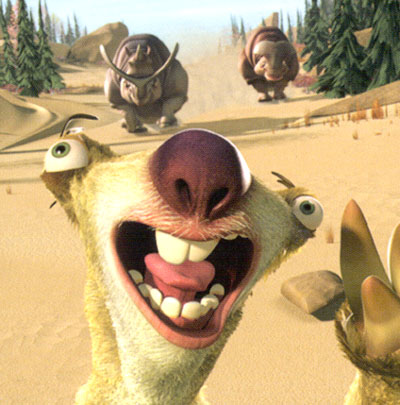 |
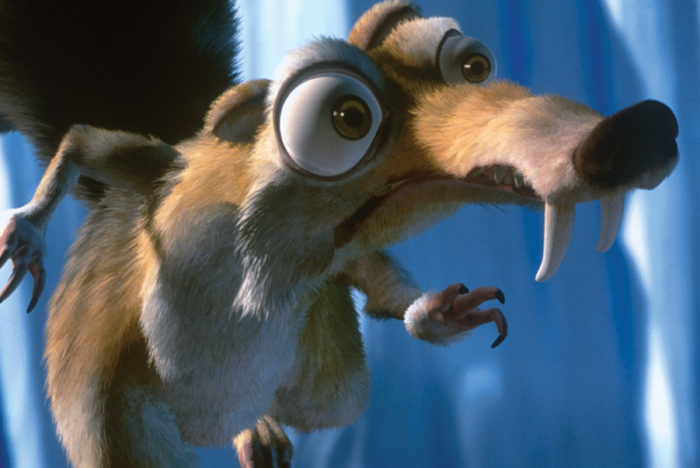 |
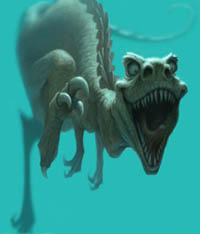 |
March 2002 Interview by Dark
Horizons's Paul Fisher
This is your first feature, was it hard to make the transition?

No, it was a transition I've been looking forward to since I was about
12 years old. So, no, it was fun. We felt completely prepared for it.
Why this particular period of history?
Well, it was a concept that Fox had been kicking around for a little while and they had a draft of the story together which ended up being the main bones of the dramatic story of Ice Age. What appealed to me about it was just that the setting was just kind of ripe with possibilities for invention and exploration. The ice age doesn't sound sexy when you first say it. But when you look at it, it's the world in transition. All these animals that were hanging around for who knows how long and suddenly the climate is changing and humans are appearing. It just seemed like an interesting pressures on these guys and an interesting world that is both kind of familiar and alien, because it happened so long ago, in a place that we live on now, that looked a lot different back then.
You were told no dinosaurs, but most people believe that dinosaurs were killed off by the ice age?
No, I don't think so. I think it was a giant meteor. Interestingly, enough there are ice age cycles that happen. We are talking about the most recent ice age that ended, I think about ten to twenty thousand years ago. The polar ice caps descended down as far as the middle of America. New York City was under a mile of ice. Of course, it wasn't a city then. It wasn't a city until the glaciers receded. But the dinosaurs were off the stage for about 300 million years from what I understand.
Did you actually research the ice age for this project?
Yes we did. I felt an obligation. I felt duty bound to research the ice age when we started and then I felt like throwing it all out the window and making a comedy about it when we got to start making the movie. We did do a lot of research.
Why did you decide to do the voice of Scrat?
Well, we do all the voices before the actors do, because we cut the movie together with just the storyboards and our voices to start working on the pacing of it. We kind of make the whole movie backwards, we edit it first and then we execute all of the animation. So, one afternoon we needed the sound for that Scrat to be running, screaming, being manic and so I put it in and that's just what we kept.
How hard is it to cast these projects? Where did Ray Romano's name appear?
Ray wasn't the obvious choice for us, because what we first thought was that Manny's voice should be a big deep voice and we went for James Earl Jones types and played those up against the drawings of our character and they sounded big, but they sounded kind of obvious. Ray was a suggestion I think from the casting people at Fox. Some actors when you take their voices away from their faces they just sound like you or me. But Ray's when you take his voice away from his face, it sounds like Ray still. When we put that voice on our character we had something really unique. I think a lot about Ray's demeanour, he's a big kind of teddy bear anyway. We just made a bigger version of that.
You couldn't see his mouth move, was that a challenge?
It was a challenge for us because it takes away some of the elements that we use to make faces expressive, but it left us with the most expressive part of a character's face; the eyes. If you think about the mammoth, all you have is the eyes and the head. He can't even use his arms. He doesn't have any. He stands like a table and so his eyes, his gesturing and Ray's voice do all the acting.
The trunk was pretty amazing. Was that new technology?
There was no new technology for the trunk other than fur we had developed to apply to everything. That kind of flexible shape changing animation has been around for a while. It's all design that makes it look and move the way it does.
What about the footprints in the snow?
Actually, we did come up with a very clever technique where that all happened automatically. The technical directors were able to give us that capability automatically, so when they stepped a footprint would be there and when they ran they'd kick it up. We chose a style for the movie that didn't require us to make everything look perfectly, photographically realistic. We picked a style that we knew we would be able to apply to everything evenly, so some of those weather effects, rain and snow, end up making it look really real.
Are you aware of what the other animation studios are working on and their similarities to your project? Does that concern you while you are making a film?
You can't think that way. The films that we were reacting to were films that have been done when we started the movie, films that were done three years ago, and two years ago. But by the time some of the films that people inevitably compare us to were in the theatres we were finished with animation. Certainly finished with story and it was just rendering it up and doing the post on it. Whatever similarities there are, it may be just some group consciousness at work.
What about the human characters?
Well we stylized the humans certainly. We didn't feel any. . . I wasn't interested in making the humans look realistic at all. There are five billion humans on the planet right now, if you can't find one of those to use than you've got trouble, but we styled them along with the style of the whole movie and I think it makes them more convincing somehow. The notion that they don't speak is just that they are not central to the story. They are just kind of the maguffin in our story. They are the things you have to get to and deal with. What happens along the way is the real story and it's all told from our character's perspectives.
How serious do you think Fox is about animation?

Well, Blue Sky has been it's own company. Blue Sky is in New York.
We're 3,000 miles away from the studio and we have nothing to do with the
history of animation at Fox before us. We just weren't involved with it
at all. I can't speak for Fox. Hopefully they are excited about the movie.
I think they are. And excited about the future potential of Blue Sky.
Did Fox come to you?
Fox came to us with the concept for Ice Age and they came to us with the first draft of the script. They also gave us a mandate to make it into a comedy from what was previously a rather dramatic action concept.
Do you expect other studios to buy animation houses?
It costs a lot of money to make these because there are so many people involved and so much technology. There's a lot of overhead involved with it. Nobody really wants to be saddled with it. We carried it on our own for a long time and Fox came along as a partner that would help us grow the company to the point that we could make a feature film. We added a hundred people to our staff in a year. So you need the kind of investment, marketing and distribution muscle that a company like Fox has.
How many other projects do you have in development?
Well, we have one that's quite far along in development right now and there are ideas in behind it. We are still a relatively small company in comparison to some of the other studios that are out there. We are hoping that there will be some success associated with Ice Age that will allow us to build up more of our own internal development.
What were some of the major decisions you had to make to get this movie to the screen?
We had a lot more material than what ended up in the film. In spite of it all, I wish we had more time to add more to the movie. There were more characters. We actually had to cut some characters out. We spent more time with the tigers. We spent more time with some of the extras. There was a romantic interest for Sid that is really brilliant, funny stuff that will appear on the DVD. There were things we cut for pacing issues. Sid's girlfriend we cut completely for pacing issues. We just wanted to get the story started faster. We made some changes to the story late on for the end of the story, that knocked out our ability to do a tag sequence that was going to tie up a couple of the other characters so there was no point in having them. There was some tone stuff that ended up cutting, especially we took the hot tub scene a little further than it appears in the movie. Some of the funniest stuff to us we had to cut because you could tell it just wasn't playing.
If you started as a drama when did you realize you wanted to make a comedy?
Fox said, 'Let's make this movie and we'll make this movie with Blue Sky as long as they can make it into a comedy'.
Was that tough?
Yes, it was very hard. Comedy is hard. For idiots like me, it's really hard.
Were you surprised at the success of the teaser trailer?
You know I resisted that idea at the beginning because I always want to save everything for the audience. So every time I see a new gag in a commercial, I ask them 'Please do you have to show that gag.' They say, 'Don't worry, there are so many gags in the movie, nobody is going to feel like they've seen them all in the marketing.' That was a sequence where I was really looking forward to seeing how it played and ironically, as many times as people have seen it in the theatres or on the Internet, they laugh their heads off.
How surprised are you by this movie?
I'm really happy with it. I knew going into it we would solve it. I knew going into it that we would solve it. We weren't sure what we were going to have when we started, but inevitably you pull things from that creative ether that you don't expect to find. You put all the ideas you can into the movie at the beginning and then after a while you've created a Frankenstein that starts to live on its own. It has its own personality and it kind of tells you where to go. It's really like raising children. You have no idea what you're going to start out with and then you have something that looks like you when you're done.
Does the animation community talk to each other?
I'll tell you it was back when we were younger and more innocent, we used to talk about what we were working on all the time. There's a fair amount of openness. I think everybody knows, most of the people that could take advantage of it and know what we're working on next and we know what people are working on.
What about the Academy Award nominations for animated features?
I hope it does get one every year. You need to have enough movies so that three nominees are warranted. Actually I'd like animation to be accepted so it doesn't feel like a niche category. There's a perception that has been attached to animation and I can't think, some film historians are going to have to help me figure out where it started, that animation is for kids and I think that's kind of restricted the amount of serious attention the Academy pays to it anyway. They're pandering, it's for kids anyway. It's not serious. I think there's some of that going on.
Adult animated movies don't seem to do well. They do in Japan.
Maybe it's a cultural thing. I don't know. I'm not saying that I'd change anything about our movie because I think it's something. . . you don't have to be a kid to enjoy our movie for sure. We didn't dumb it down for kids. I'm excited that animated films will get their recognition now, because they take so long and they take so much work by so many talented people.
Do you envy other studio's technology?
I like the way our fur looks. The technology kind of evolves at a pace. It's kind of fuelled by the amount of people that are into it, but you can kind of tell how fast it's going to go. It's happening a lot slower than I thought it was going to go and I've been doing this for twenty years. But the one thing that all these. . . the successful films that people point to have a decent story and that has nothing to do with the technology at all and that's why I think there may be some point in the future when someone wants to take a risk and spend this much money on a film that's just for adults. You may end up with a Matrix movie that's all CG, that actually hits because there's a story there.
Did you ever realize that this story is Three Men and a Baby?

Yeah, I mean I was really trying to play any kind of label down on
the movie. There are definitely moments where you have that three men and
a baby thing going on, but I wanted it to be less about the baby and more
about the relationship of these three guys. Last night at the very end
when they were waiving bye I was sitting at the back of the theatre, Sid
goes, 'Goodbye' and I heard this little voice behind me, 'Goodbye'.
Was there ever a temptation to throw in a couple of songs?
Never for the characters to sing. There wasn't really any pressure to do that. Ray probably has a pretty good singing voice.
Couldn't Scrat be part of a short?
Well, yeah. I think it's the economics of making the shorts that have doomed them long ago. I've made a lot of short films and I can tell you there is absolutely no way to make a living doing it. You can work on something for three years and then make about $3,000 in prize money after a full year of having it tour around the world. Bunny made as much prize money as you could possibly ask for and I couldn't run the household on it, plus I had to distribute it to all the people that worked on it. We made a fund at Blue Sky. . . basically we threw a lot of parties with the prize money.
And where do you keep the Oscar?
Oscar is home sitting on the shelf.
November 2002 Interview by AICN's Harry Lime
First of all, that teaser trailer... amazing. The first time I saw it, I was taken aback by how perfect it is. It’s so good it could easily stand alone as a short film. Was it a daunting task following that up with the remaining eighty minutes?
The following eighty minutes was absolutely more daunting. Scrat came easy.
And you provided Scrat’s voice in the film. Will you consider doing larger roles in future projects?
I wouldn’t rule it out. We all do a lot of scratch dialog recording for the films while we are creating the story reels.
That reminds me of Joe Ranft voicing Heimlich in A Bug's Life. I think it would be really cool to watch an animated movie that uses only the animators as voice talent. In the teaser for Ice Age, there’s no dialogue, except for Ray Romano at the end. Was there ever a consideration about doing the entire film without human voices?
Not then. The story for Ice Age was already set, and it required dialog. I just wanted a better opening. The Scrat sequence was born from my feeling that the landscape should be a character as well. The Ice Age itself should have a presence. It would terrorize a hapless creature, and hence the Scrat.
Did the actors who voiced the characters of this film influence the finished product in any unexpected ways?
The actors were encouraged to improvise as much as possible. Some of the best comedic moments were improvised. It was a great tool for me, because if we came to a line that I hated, I could push the actors to do something else, and usually we got something better.
Is there an actor you’d sell your soul to direct a vocal performance out of in an animated film down the road?
That would depend on the role, but there are a couple of people that have great animation voices that I’d love to have. I wouldn’t sell my soul for them though. I’ve got bigger plans for it.
The recent collaboration of Rob Coleman and Frank Oz on Yoda in Attack of the Clones resulted in one of the year’s finest performances. Clearly, the true star of the movie is Yoda. They’ll probably get overlooked for an Academy Award, though, in the Best Supporting Actor category. When do you think this kind of acting will finally get the respect it deserves?
It’s tough because no one person creates an animation performance. The actor provides the voice, but some else has designed it, someone else has animated it, someone else has directed it, etc, etc. One thing is for sure, we are going to see a lot more of these performances. But yes, I think Yoda deserves an Oscar for that. It made watching the rest of the movie completely worth it.
Do you plan to ever direct a live action or a live action CG mix?
We have done a bunch of effects projects at Blue Sky including my personal favorite, Joe’s Apartment. Whatever technique is employed on future projects will be dictated by the story.
You co-directed this film with Carlos Saldanha. What is it like collaborating on a film like this?
I think you have to know each other very well. Carlos and I have been working together for eight or nine years. When you work closely enough you share a lot of experience and a lot of trust. I have to know that he can take ideas from a certain point and finish them. I have to stand by decisions that he makes when I am not available. Another approach is to have a lot of lieutenants and give them plenty of responsibility and accountability.
Did you guys see it as a big challenge entering an arena that’s mainly dominated by Disney and DreamWorks? Did this affect the way you approached crafting this film?
I don’t believe that anyone has a monopoly on good ideas. If you worry about what other people are doing you will lose focus on your own work. We pounded on ICE AGE for as long as we had time for and then we sent it out. We will do the same for the next one. We can’t worry about competition. Besides, you aren’t competing with anyone but yourself. They have nothing to do with whether you make a good movie or not.
Was there material that was cut from Ice Age that made you cry to see it go?
Plenty. There were many ideas that were thrown out too. You can see a few sequences on the DVD.
An animator friend of mine told me that if the film works at the
boards stage, it’ll work when it’s finished. How did the storyboard phase
of Ice Age go? When did you know it was working?

That’s true. Story is by far the hardest part. You might think that
each stage of production, (story, layout, animation, rendering, etc.) adds
to the effect, and improves the movie, but it merely magnifies what you’ve
got in story. If it’s a good story, it gets better. If it’s a bad one,
all the extra work just makes that fact more obvious. We kept story alive
for the entire production of Ice Age. It changed daily, even while sequences
were being animated and rendered, sometimes even after. We learned more
about the movie and the characters as we went and fed that back into story.
It got better and better at each test screening. We were almost two years
into making the movie before I felt confident that it would work, and that
was just on a logic level. It took longer to get the tone of the comedy
and the emotion to play right. I still think we could improve it, but hell,
you have to stop at some point.
I’ve always believed that you have to be a pretty unique individual to be an animator. I say this with the utmost of respect for them. How would you describe most of the animators you’ve worked with?
The best animators I know are obsessed with detail. They are magnificent observers and they are talented actors, albeit usually shy. They have the ability to analyze motion, which is hard because it doesn’t sit still for you to observe. If you are unsure about whether an animator has the right stuff, get them drunk at a party and see if they can dance.
Some of the look of Ice Age is very realistic, while other aspects are quite stylized. How difficult is the process of deciding how to play a film like this visually?
Stylization was a survival tactic. There was too little time or money to make it look realistic. I chose to put the detail on the characters and simply suggest the environments rather than explain them with a lot of detail.
Are you tired of cute, cuddly creatures infesting the world of animation?
Sounds like you are.
Actually, I don’t mind them. Sorry if it came out that way. I just wish there were more animated films aimed at an adult audience.
We had a cuddly baby in Ice Age that we all tried to downplay at the beginning. After a while we realized that it had a role to play--being cute invested the audience and raised the stakes. I’ve heard people gasp from the cute quotient when it first hits the screen. My kids are cute. Cuteness is a part of what makes the world go round.
Do you think it's fair to say that 3D animation is beating the crap out of traditional animation?
I hate this question. At some point soon a 2D movie will come along and kick butt, and people will stop asking it. It’s not a competition.
What was your favorite Disney animated film as a child?
Bambi, for the style. Dumbo for the music. Pinocchio for the terrifying donkeys. And Mary Poppins because I thought she was pretty.
I heard somewhere that you wanted to make movies ever since you were twelve. Was it a particular movie you saw that sent you down this path and how has it shaped you as a filmmaker?
My mom called me in to watch a TV show about a place called The Yellowball Workshop, where they taught kids to make animation. They showed some cut-out animation techniques that looked cool so I tried it. King Kong played at our local movie theater around then and I really got jazzed by that. I was into Rankin-Bass Christmas specials and Ray Harryhausen movies. I spent summer vacations fooling around with my dad’s 8mm movie camera, doing little animation experiments and special effects. Then I started telling little stories. They were short. I think a roll of 8mm film only plays about two minutes. By the time I was in high school I was making 16mm epics. I guess the biggest influence is that I've been thinking about it for a long time. I won't tell you how long.
What was your very first attempt at filmmaking?
My first attempt was a little movie about my brother escaping from a wicked wizard played by my sister, who lived in our basement. (My sister didn’t live in the basement, the wizard did.) She popped magically into and out of scenes. Very tricky. I think he got out, but then she was waiting for him and zapped him dead.
What was it like working on Tron? At the time, which was twenty years ago, what were your thoughts on the future of CG on the big screen? And where do you think this art is headed in the next two decades?
I remember feeling that technology was like trying to draw with your
foot. In a ski boot. It was the most indirect way to work imaginable, but
the potential had us all excited. I started in stop motion. Dimensionality
and lighting were what inspired me - the ability to make something look
real that was obviously impossible. This is what the computer was starting
to do and when we thought about what would be going on in twenty years
we knew we were in the right place. Unfortunately our ideas were that far
ahead of the times and it took a while for the technology, the business,
and the audience to catch up. I feel fortunate to have been there at the
time. All of that experience adds up to what we are doing now and what
we are planning for the future. This technology will obviously become more
prevalent. Who knows what will result? One thing is certain, computer technology
will revolutionize the way we tell stories as much as movie film has.
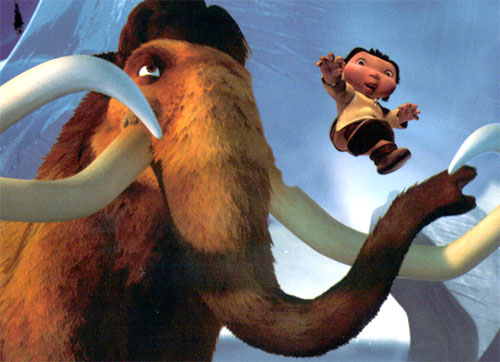 |
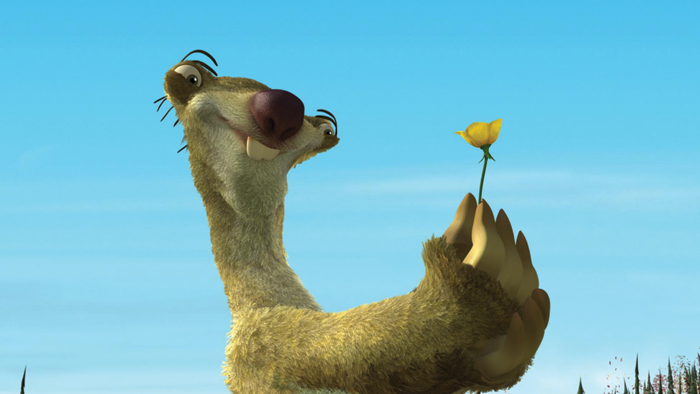 |
 |
Taken from About.com
in February 2002
Blue Sky Studios produced the animation for the film, under the guidance of director Chris Wedge, using a unique technology called Raytracing to make their CGI animation stand out.
"There are actually theoretical physicists on our staff at Blue Sky that understand the physics of light to the extent that they can mimic it inside the computer," Wedge said. "What they track are the complexities of light, the way that light rays, the way you learn about it in high school, photons I guess, spray into a scene and splash around and create all the complexities that we associate with the way the world looks. And I think you'll be able to see when you look at the imagery today that there is an almost storybook appeal to the characters because partially the way they're rendered with this technology."
Wedge felt the ice age was the perfect setting for an animated film,
as it allowed a balance between realism and artistic freedom.
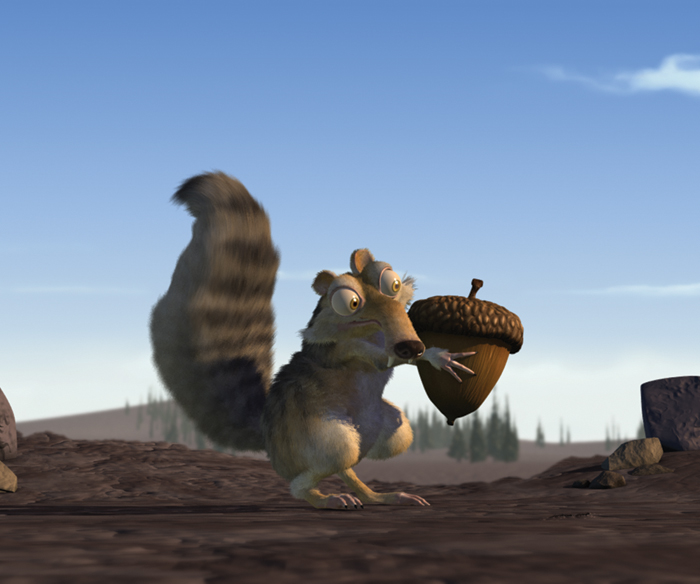
"It seemed to me that when we first started in on it that we could
take quite a bit of creative license because no one was actually there,"
Wedge said. "We did a little bit of research. We spent quite a bit of time
at the American Museum of Natural History in New York looking at mammoth
bones and the great murals that were painted there. [We] actually consulted
with an anthropologist there, Dr. Randall White, who told us, 'Yeah, pretty
much take whatever creative license you want to. Just do me one favor.
Promise me you won't put any dinosaurs in the movie. The dinosaurs were
extinct about 350 million years before this.' We made him that promise
at that meeting but we managed to slip one through anyway. You'll see how
we did it. But it seemed to me that we could have a lot of fun making the
ice age itself a character in the movie and make an animated world and
use it to kick off the story."
Romano plays the lead character, a woolly mammoth named Manfred (pictured at right with Sid the sloth). He joked about the producers requests on his talent.
"What was weird was when they came to my dressing room on my TV show and when we talked about it, I said, 'This will be great. I'm playing a mammoth. I can put a little spin on my voice.' And they said, 'No, no. What you're doing right there is fine. Do that voice right there.' I didn't know whether to be flattered or not. Everyone else was putting on cartoon voices and I just had to talk like myself. But it was a lot of fun to do. This is my transition from TV and I think it's good that I weaned the audience slowly to myself. First my voice. Next, I'll do like a back shot of me or something."
Since the heroes of the film are talking animals, Wedge decided to humanize them while humans in the film are portrayed as more animalistic. "It's a movie where all the animals talk and none of the humans do," Wedge said. "It's kind of shot as if the characters were humans and whenever we see the humans, they're shot more like nature photography."
Manfred and his companions journey through environments from ice caves to volcanoes, encountering antagonists from vicious rhinos to comical dodo birds. However, Wedge emphasized the film's emotional themes.
"I think one thing that's going to surprise a lot of people about our
movie is I think you're going to go expecting to see a lot of great humor
and action and adventure as you would when you go to most animated films,"
Wedge said. "But what you find as our film progresses is that there's a
lot of heart as these three characters find a bond. They all kind of dig
into their pasts. The themes it explores are about family and the different
forms that it takes, family breaking apart and families coming together
and finding family where you least expect to."
|
||||||||||||